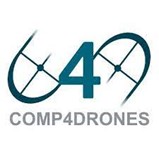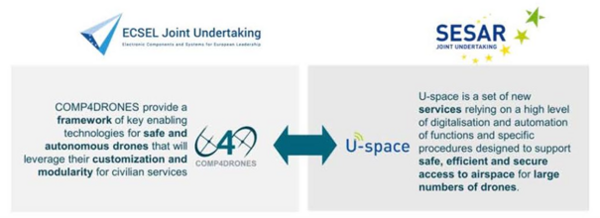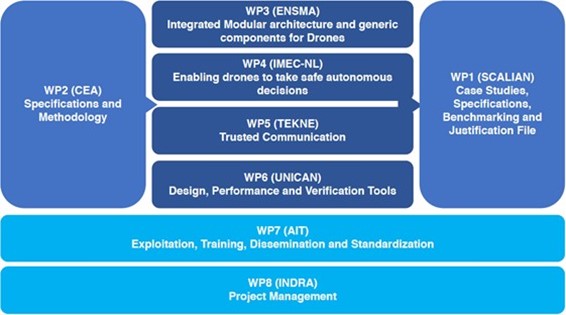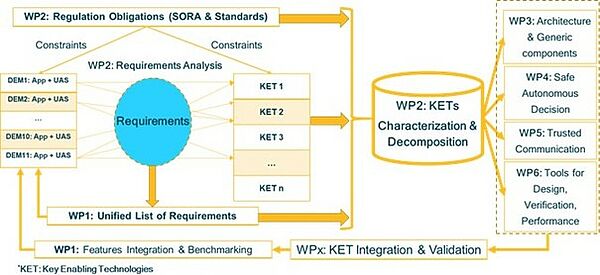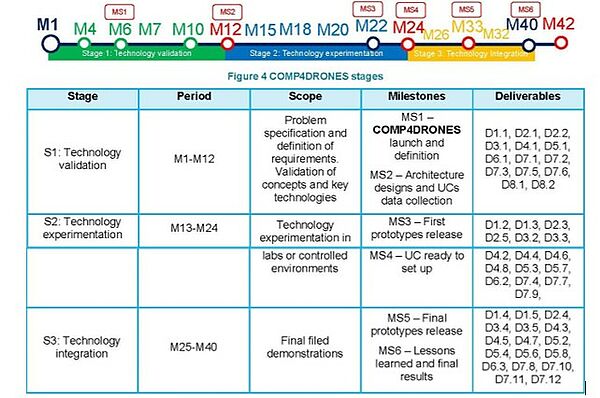Framework of key enabling technologies for safe and autonomous drones’ applications
COMP4DRONES brings to bear a holistically designed ecosystem, from application to electronic components, realized as a tightly integrated multi-vendor and compositional UAV embedded architecture solution and a tool chain complementing the compositional architecture principles. The project mainly focusses on the following specific objectives:
O1: Ease the integration and customization of embedded drone systems.
O2: Enable drones to take safe autonomous decisions.
O3: Ensure the deployment of trusted communications.
O4: Minimize the design and verification effort for complex drone applications.
O5: Ensure sustainable impact and creation of an industry-driven community.
The project is structured in eight work packages (see Figure 2). The Case Studies and Benchmarking work package (WP1) is one core element driving the project with its needs and requirements in terms of Specifications and Methodology (WP2), Integrated Modular architecture for Drones (WP3) Safe Intelligent Navigation (WP4) and Trusted Communication (WP5). The Design, Performance and Verification Tools work package (WP6) is an essential brick to enable safe design and verification of embedded platform for civilian drones. WP7 is dedicated to promoting the industrial impact, ecosystem building, standardization, workshops and training, to support the market take-up. Further partners will actively push exploitation as well as dissemination activities. The Project, Risk and Innovation Management (WP8) coordinate all project activities and decisions of the project.
The project approach is cooperative between end-users, technology providers and researchers. It consists of streams of tasks as illustrated in Figure 3. First, the different demonstrators are specified (i.e., scenarios, features, and functional and non-functional requirements). The demos’ requirements are then analysed to get a unified list of requirements (WP1). Second, the unified list of requirements is used to identify the key enabling technologies (KET) that are going to be developed during the project (WP2). Third, the identified key technologies are characterized and decomposed into the project working packages: the architecture and its generic components (WP3), technologies for safe autonomous decision (WP4), trusted communication technologies (WP5), and tools for design, verification, performance analysis, etc. (WP6). Fourth, the developed technologies are integrated and validated. Finally, the key technologies are evaluated by using them for the development of different demos (WP1).
The main project activity is to provide a framework of key enabling technologies for safe and autonomous drones. It brings to bear a holistically designed ecosystem from application to electronic components, easing the development of
new application and functionalities on the fields of transport, construction, surveillance and inspection, logistics, and agriculture though the deployment of 5 use cases (UC2: Construction has stopped on 31st March). The project activities are structured in 3 stages (see Figure 4). Each of these stages are characterized by a set of aspects as described in Table 1. This document reports the work done during the second reporting period (PR2) of the project and therefore most of the stage 2 has been completed.
- Partner: INDRA SISTEMAS SA, AIT AUSTRIAN INSTITUTE OF TECHNOLOGY GMBH, FORSCHUNG BURGENLAND GMBH, Weinbau Martin Moravitz, INTERUNIVERSITAIR MICRO-ELECTRONICA CENTRUM, VYSOKE UCENI TECHNICKE V BRNE, ZAPADOCESKA UNIVERZITA V PLZNI, HONEYWELL INTERNATIONAL SRO, Andarta Robotics, ECOLE NATIONALE DE L AVIATION CIVILE, SIEMENS INDUSTRY SOFTWARE SAS, EUROGICIEL, ECOLE NATIONALE SUPERIEURE DE MECANIQUE ET D'AEROTECHNIQUE, ABINSULA SRL, ALMA MATER STUDIORUM - UNIVERSITA DI BOLOGNA, UNIVERSITA DEGLI STUDI DEL SANNIO, UNIVERSITA DEGLI STUDI DI SASSARI, UNIVERSITA DEGLI STUDI DELL'AQUILA, TEKNE SRL, TOPVIEW SRL START UP INNOVATIVA, ELEKTRONIKAS UN DATORZINATNU INSTITUTS, LATVIJAS UNIVERSITATES MATEMATIKAS UN INFORMATIKAS INSTITUTS, ANYWI TECHNOLOGY BV, STICHTING IMEC NEDERLAND, THALES NEDERLAND BV, Skyability GmbH, TECHNISCHE UNIVERSITEIT EINDHOVEN, INSTITUTO SUPERIOR DE ENGENHARIA DO PORTO, ACCIONA CONSTRUCCION SA, ACORDE TECHNOLOGIES SA, HEMAV TECHNOLOGY SL, HI IBERIA INGENIERIA Y PROYECTOS, IKERLAN S COOP, COMMISSARIAT A L ENERGIE ATOMIQUE ET AUX ENERGIES ALTERNATIVES, UNIVERSIDAD DE CANTABRIA, AITEK SOCIETA' PER AZIONI, SmartMotion s.r.o., Atechsys Engineering, Airobot NV, UBIMET GMBH, TECHNISCHE UNIVERSITEIT DELFT, DEMCON unmanned systems, Ud'Anet Srl, SHERPA ENGINEERING SA, Aitronik srl, LATVIJAS MOBILAIS TELEFONS SIA, RO TECHNOLOGY SRL, Modis Consulting, INFINEON TECHNOLOGIES AUSTRIA AG, ALMENDE B.V., Masarykova univerzita, TOTAL S.A., ALTRAN TECHNOLOGIES
- Förderprogramm: H2020-ECSEL-2018-2-RIA-two-stage, ECSEL-2018-2-RIA
- Projektlaufzeit: 10/2019-01/2023



